Camden County, Georgia
| Camden County, Georgia | |
|---|---|

Camden County Courthouse in Woodbine
|
|
 Location in the U.S. state of Georgia |
|
 Georgia's location in the U.S. |
|
| Founded | 1777 |
| Seat | Woodbine |
| Largest city | St. Marys |
| Area | |
| • Total | 782 sq mi (2,025 km2) |
| • Land | 613 sq mi (1,588 km2) |
| • Water | 169 sq mi (438 km2), 21.6% |
| Population | |
| • (2010) | 50,513 |
| • Density | 82/sq mi (32/km²) |
| Congressional district | 1st |
| Time zone | Eastern: UTC-5/-4 |
| Website | www |
Camden County is a county located in the southeastern corner of the U.S. state of Georgia. According to the 2010 Census, the population was 50,513. Its county seat is Woodbine, and the largest city is St. Marys. It is one of the original counties of Georgia, created February 5, 1777. It is the 11th largest county in the state of Georgia by area, and the 41st largest by population
Camden County comprises the St. Marys, GA Micropolitan Statistical Area, which is included in the Jacksonville-St. Marys-Palatka, FL-GA Combined Statistical Area.
The first recorded European to visit what is today Camden County was Captain Jean Ribault of France in 1562. Ribault was sent out by French Huguenots to find a suitable place for a settlement. Ribault named the rivers he saw the Seine and the Some, known today as the St. Marys and Satilla Rivers. Ribault described the area as, "Fairest, fruitfulest and pleasantest of all the world."
In 1565, Spain became alarmed by the French settlements and sent out a large force to take over and settle the area. During that time, the Spaniards attempted to convert the Native Americans to Catholicism. At least two missions operated on Cumberland Island, ministering to the Timucuan people, who had resided on the island for at least four thousand years.
Competing British and Spanish claims to the territory between their respective colonies of South Carolina and Florida was a source of international tension, and the colony of Georgia was founded in 1733 in part to protect the British interests. The Spanish theoretically lost their claim to the territory in 1742 after the Battle of Bloody Marsh (on St. Simons Island). However, settlement south of the Altamaha River (what is now Glynn and Camden Counties) was discouraged by both the British and Spanish governments. One group of settlers led by Edmund Gray sparked Spanish military action after settling on the Satilla River in the 1750s near present-day Burnt Fort, and were subsequently disbanded by the Royal Governor John Reynolds.
...
Wikipedia
